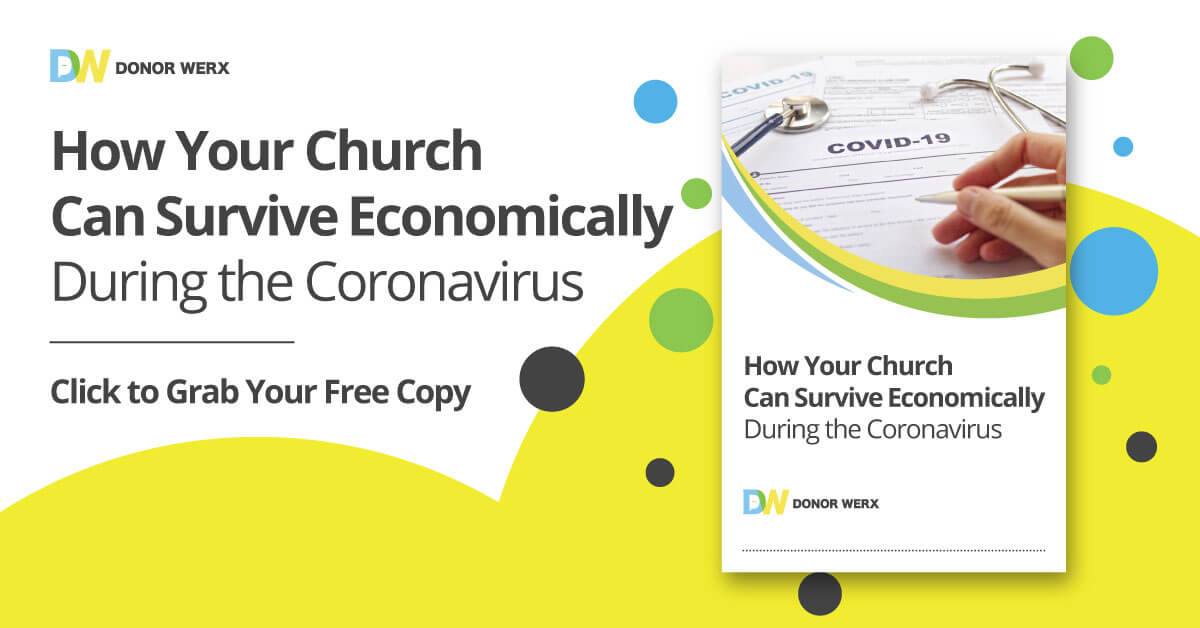Ways to Help Your Church Survive Coronavirus Economically
Can your church survive coronavirus economically? This can be done, and it’s even possible to thrive.
DOWNLOAD YOUR FREE PDF COPY HERE (NO OPT-IN REQUIRED)  `The unprecedented spread of the coronavirus has had a ripple effect into every aspect of public life. Unfortunately, this even reaches into the attendance numbers at church services. You’ve likely already seen a reduction in turnout at your worship gatherings, and if this is the case, you’re no doubt worried about the economic strain that may come.
`The unprecedented spread of the coronavirus has had a ripple effect into every aspect of public life. Unfortunately, this even reaches into the attendance numbers at church services. You’ve likely already seen a reduction in turnout at your worship gatherings, and if this is the case, you’re no doubt worried about the economic strain that may come.
The fact is that lowered attendance typically means less giving. The combination of coronavirus concerns and the economic uncertainty that has accompanied these fears makes the potential outcome even worse. And when you consider the major religious holidays in April – just over two months after the first reported case in America – the pandemic’s timing couldn’t be any worse for churches.
Can Your Church Survive Coronavirus Economically?
What does this mean for your church? After all, missing out on the tithes and donations that come from major religious holidays could prove disastrous for some houses of worship. Fortunately, there are ways to combat coronavirus regarding church giving. You should never forget the concern of your congregants and donors during this time, but there are proactive steps you can take.
The most important thing to remember is to not downplay the seriousness of the disease. Mentioning detailed statistics is folly at this point – owing entirely to the fact that droves of new infections are reported every day – but the pandemic really is spreading faster than anyone could have imagined. And if you don’t take this seriously, it’s unlikely that your congregants will.
Things can change in a blink of an eye, so it’s important to stay informed as much as possible. While doing so, however, keep the following tips in mind and stay active in keeping your church healthy. The Bible tells us in 1 Peter 5:2 to watch over and remain shepherds of the flock that God has entrusted to us – not because we must, but because we are willing.
In our current situation, this means ensuring the church survives while safeguarding the health of parishioners. After reading the following information, you’ll be fully prepared to do so.
Dealing with Coronavirus with In-Church Giving
Federal orders banning public gatherings are rare, but they’re now a possibility. In fact, the Centers for Disease Control (CDC) recommended cancelling events with over 50 people only two months after America’s first reported case. Many churches continued holding services, but this call should be based on recommendations from public health officials. Still, there are some things you should know in advance.
Your most important consideration should be your at-risk congregants. The major coronavirus issues are occurring to older individuals. Unfortunately, these are typically your most devoted attendees. A full 48 percent of individuals aged 65 and older attend church at least weekly, and 38 percent of those 50-64 years old can say the same. This number drops to 33 percent and lower for individuals younger than 50.
Due to the disproportionate effect this disease will have on your elderly parishioners, it’s vital that you ask them to worship from home. We’ll explain later how you can bring church services right to their living rooms. For everyone else, here are the ways you can make services and collection of offerings safer:
Revise or Eliminate Meet and Greets
One of the most common practices at churches involves congregants standing to speak and shake hands. Many church leaders have recommended “fist bumps” instead, but eliminating this practice altogether is advisable. One person getting the entire congregation sick can be detrimental to your church spiritually, emotionally and financially.
Change Offering Practices
Some churches already use collection plates with handles to minimize parishioners’ physical contact with the offering. Even those who use these novel instruments, however, should consider changing their offering practice entirely. Instead, place collection plates at the entrances, exits and throughout your church. Make sure to remind the congregation to give during the closing of service.
Don’t Be Afraid to Be Honest
There’s a serious problem with trust in the pulpit. A study of protestants found that 54 percent would change churches if the preached doctrine changed. Conversely, only 12 percent would make this choice if the preacher left. Avoid distrust by explaining to your congregation that the church will be facing dangerous economic times due to the coronavirus.
They’ll appreciate your honesty more than any attempts to convince them that the Bible makes it their duty to give. Even if the Holy Book specifically says that believers should donate, it can still come off sounding like a sales pitch. Now is the time to be straightforward – because churches will find it difficult to survive this pandemic without continued giving.
Focus on Cleaning and Sanitation
You should provide hand sanitation stations throughout your church. Have someone at the entrance to pump sanitizer into each parishioner’s hand to ensure they use it. Make sure you clean and sanitize all common and high-traffic areas between services as well. Door handles, chairs, counters and elevators are just a few of the places that should be cleaned repeatedly.
Overcommunicate Your Measures
Even if you’re still holding church services, it doesn’t mean your members are necessarily going to show up. They’re fearful at this time, and if your tithing and donation strategy is focused mainly on in-church attendance, this can prove detrimental. This means you should overcommunicate the steps you’ve taken with your congregation.
They need to know that you’re taking the spread of coronavirus seriously. Head to social media and let them know the procedures that are underway to prevent the spread of the virus during services. Share tips on how parishioners can engage in personal prevention. Let them know that you’re staying well-informed on new developments – because instilling trust in your congregation is integral.
Should I Even Be Having Service?
Exempting a local, state or federal order to end public gatherings, church leaders will likely remain confused over whether they should discontinue services. Even if a mandatory ban isn’t put into place, you should follow guidance from health and governmental authorities. Once recommendations are made to limit gatherings, you should strongly consider them even if they’re not compulsory.
In the end, the overall effect of the coronavirus could rest upon how quickly we act. Canceling services even before it’s recommended could lessen the eventual effect of the pandemic in your community. Fortunately, there are many ways to keep congregants engaged and giving while social distancing is taking place.
Setting Up a Virtual Service
It’s likely that you’ll have to shutter your church doors at some point. In fact, many American houses of worship are already facing this reality due to some localities’ bans on large gatherings of people. Unfortunately, this greatly reduces the likelihood that parishioners will tithe or donate. If they’re not actively engaged in church services, their typical giving behaviors may not even come to mind.
This is where virtual services come in. There was a point when only larger churches had the resources to offer this option, but technological advancements make it a possibility for every house of worship. This is important since an ongoing poll found that 51 percent of pastors had already stopped in-person services by the middle of March.
If you’ve never conducted a virtual service, use the following strategies to get it right:
Consider Arrangement
Set up all stage events so that they’re within direct view of the camera. Parishioners will have one point of view, and that’s their computers. Make sure everything important is visible to them.
The Right Platform for a Church to Survive Coronavirus
Don’t stress yourself over trying to figure out the technical aspects of setting up streaming on your website. Tools such as Facebook Live, YouTube, SundayStreams, vMix and Dacast all offer the ability to stream live directly to your congregation. There were 3.5 billion Facebook Live streams in 2018, so it’s safe to assume the platform is solid.
Don’t Splurge on Equipment
It’s great when your church can make special purchases to improve the worship experience, but coronavirus shouldn’t be the impetus for doing so. This is especially the case since your revenue is likely to decrease. Instead, use a regular plug-and-record camera that offers live streaming features.
Let Congregants Know!
While streaming your service live on Facebook or posting a YouTube link to your social media pages will help, you must go much further to let parishioners know. Utilize your email list. Tell everyone at your last in-person service to visit the appropriate platform at the regular time. Have members go through the directory and call everyone. Spreading the word is the only way you’ll be able to share God’s word.
Proper use of your email list may be the best recommendation of all. Millions of students are learning from home due to school cancellations, and this means parents are watching their inboxes like hawks in case they receive something from their child’s educators. Consider the following steps to make your emails more effective:
- Include images and videos when possible.
- Speak to congregants’ concerns (e.g. updates on how the church is dealing with the pandemic).
- Include links to social media platforms and pages where virtual service can be viewed.
- Tell your story. Remind readers of what you’re doing and why virtual services and giving are essential.
- Utilize compelling subject lines to increase open rates.
Email may be your best method for letting congregants know about your virtual services, but you should utilize every tool available. This ensures the majority of your flock knows how to worship without physically being in a house of worship.
Remind People of How They Can Help
When congregants are sitting in your pews, an offering plate passing right in front of them is their reminder for tithing. Unfortunately, this isn’t going to happen during virtual services. This means you need to make a point of reminding your viewers to tithe. This should be a direct verbal appeal. Simply put, a “Ways to Give” slide on your live stream is unlikely to cut it.
Reminding parishioners to donate probably sounds easier said than done. After all, how can they give if there’s no physical collection plate to place their money? This is where online methods of giving come in to play, and you need to have a strong understanding of this resource if your church will survive coronavirus financially.
Online Giving Helps Churches Survive Coronavirus
The saving grace of your church’s financial health during coronavirus will undoubtedly be online giving. Of church attendees who participate in at least two weekly events outside of worship service, 80 percent prefer this form of tithing and donating. On top of this, 60 percent of all churchgoers are willing to give to your church in this way.
The reality is that online giving will be the only reasonable option for receiving donations and tithes from congregants during a sustained coronavirus outbreak. Consider the following options for collecting these donations. Implementing all these strategies will maximize the amount of money you’re able to bring in, and this is vital to maintain a strong church during these difficult times.
Text to Give: Allowing donations to be sent via text is an essential tool for churches. Elderly individuals are more adept at texting than other digital resources. Those who are 65 and over send an average of about five texts per day.
Online Giving Software: You can set up a variety of ways for congregants to tithe and donate through online giving software. Review your options since this may be your best option for continued revenue during a pandemic.
Mobile App Giving: Churches that have their own mobile apps also have several tools available that can set up donations within the app.
Online Fundraising: Platforms such as GoFundMe and Paypal allow for digital and online fundraisers. This can also now be done via Facebook. Not all these options are free, however, and some may create privacy concerns. Make sure to do research on the available options.
What’s All This Mean for Churches Surviving Coronavirus?
Setting up digital and online giving options can increase overall donations by more than 30 percent. If you’re not already accepting these forms of giving, doing so now is integral. Coronavirus will have a significant effect on church revenue, and if you’re not using every tool at your disposal, your church may find it impossible to overcome this trial.
When you focus on your donors and making it easier for them to give – while also showing that you care about their well-being – you’ll be better positioned to survive the difficulties ahead.
Your Church Can Survive Coronavirus
The church is facing an unprecedented time in America and around the world. Entire countries are shutting down along with various aspects of public life. As a church leader, you didn’t ask to be thrust into this position. This is the position God has chosen for you, though, so it’s one you should strive to bring your congregation through.
There’s no doubt that leaner times are ahead. It’s impossible to predict when the dangers presented by coronavirus will subside to a point that typical public life can continue without a measure of apprehension. By implementing these active measures and preparing for the next potential calamity, however, you’ll ensure that your church remains strong through turbulent times now and in the future.
If you need help implementing a strategy that’s donor-centric and can help minimize the effects of coronavirus on church giving, reach out to us at DonorWerx today. Our tools can help your congregation stay engaged – even if they’re not physically sitting in a pew – and ensure your donor experience continues to model excellence.
We’ll be more than happy to help you navigate through what awaits us in the coming weeks. Book a 15-minute chat with us today, and we’ll help build a plan that works for your church.


